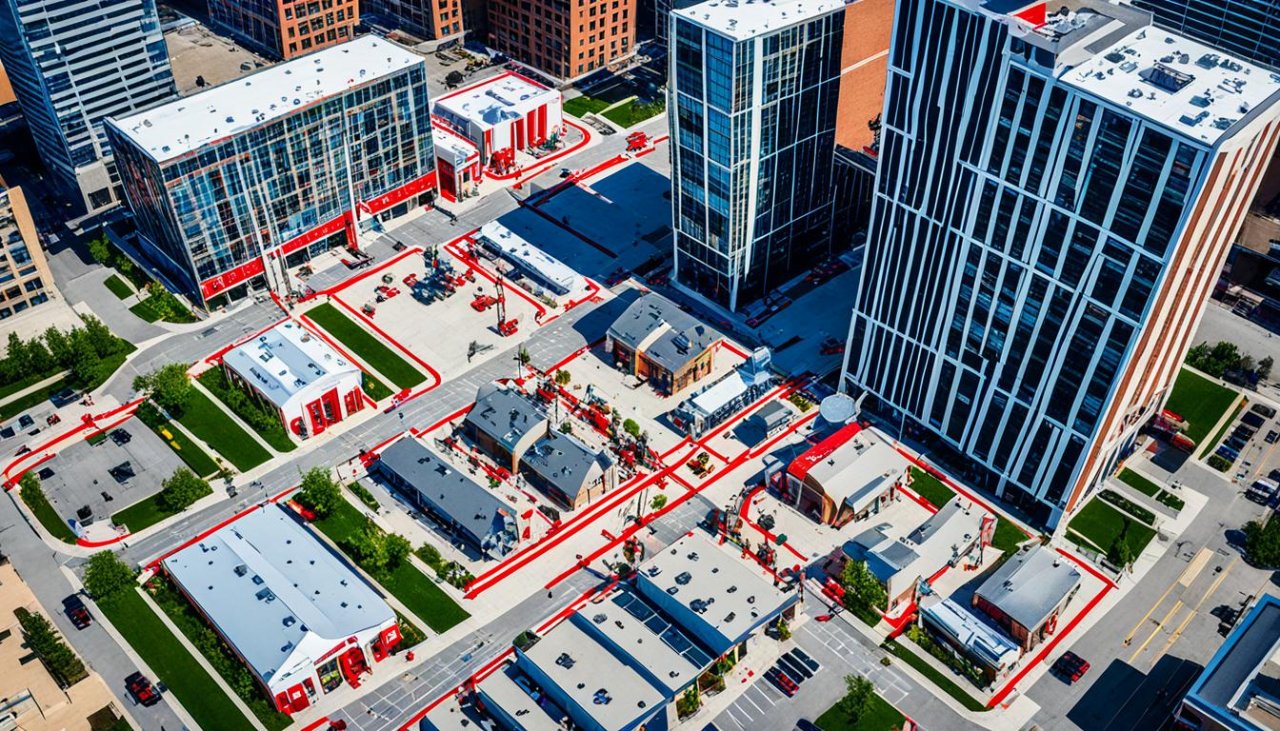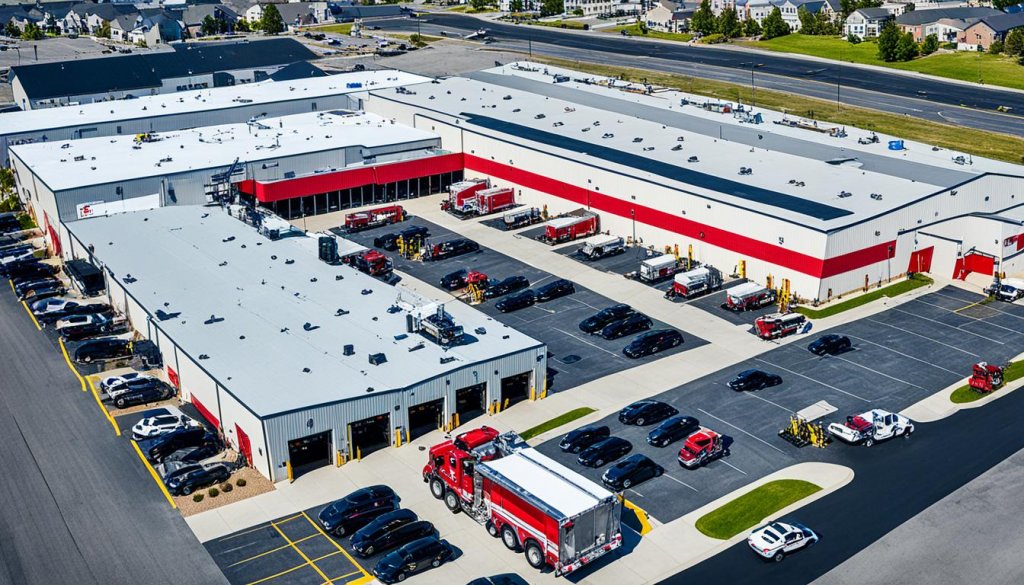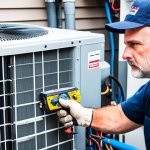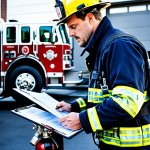Have you ever thought about how a single mistake in managing fire equipment across many sites could put many lives at risk? In today’s fast world, it’s key to manage fire equipment well not just to follow rules, but for everyone’s safety. With more complex fire safety equipment management, it’s vital to know how to coordinate different systems. Let’s look into why this coordination is so important and the challenges and solutions for keeping safety high across many places.

Key Takeaways
- Effective fire equipment multi-site coordination ensures safety and compliance.
- Understanding the components of fire safety equipment is essential for proper management.
- Proactive maintenance can prevent costly fire-related incidents.
- Coordination challenges often arise from logistics and compliance issues.
- Utilizing technology enhances real-time monitoring and response.
Understanding the Importance of Fire Equipment Services
Fire safety equipment management is key for any business. It’s not just about following rules; it shows a deep commitment to keeping employees and customers safe. Every business must take steps to ensure all locations have the right fire equipment services.
Why Fire Safety is Essential for Businesses
Fire safety is vital for protecting against disasters and keeping operations stable. Not having a good fire safety system can harm a company’s reputation and wallet. For instance, more fires in commercial buildings show we need to be more careful with fire safety.
By focusing on fire safety, businesses meet legal standards and build trust with everyone involved.
The Cost Implications of Poor Fire Equipment Management
Not taking care of fire equipment can lead to big financial problems. It might mean huge fines and higher insurance costs. Keeping fire safety systems in good shape is crucial.
Without it, a company could face big costs from damaged property and lost business. Using good fire equipment services helps reduce risks, keeps everyone safe, and looks good for the business.
Key Components of Fire Equipment Services
Knowing the different types of fire safety equipment is key for managing fires well and following the rules. Having a wide range of equipment helps in placing it in the right spots across different places. This not only keeps people safe but also reduces damage to property in emergencies.
Types of Fire Safety Equipment
Firefighting tools and devices are many and varied, each with its own role. Portable fire extinguishers are vital for putting out small fires fast. They are very useful in many situations.
Fire hoses are important for fighting big fires by delivering water. Flame-absorbing materials like Flamezorb help stop fires from spreading by soaking up flammable liquids.
Fire blankets and protective gear, like suits and gloves, shield firefighters from heat and flames. Gas-tight suits protect against chemical fires and harmful gases. Drones and thermal cameras help us see and handle fires better, making our response faster and safer.
Regular Maintenance Requirements
Keeping fire safety equipment working right means checking and maintaining it regularly. The Office of Fire Protection says it’s key to keep fire protection systems up to date. This means fixing or upgrading parts as needed.
Companies must check their fire safety gear every year, fix it, and keep it in good shape. Doing this helps with running smoothly and following the rules. Working with fire safety experts during these checks makes sure everything meets the latest standards. Regular maintenance is crucial for keeping everyone safe from fires.
Challenges in Multi-Site Fire Equipment Management
Managing fire equipment across many locations is tough. I often face logistical challenges that make safety harder. It’s key to plan well to make sure all places have the right fire gear. Codes and variances can make it harder, as they change from place to place.
Logistical Complications of Distributing Resources
Coordinating inspections and maintenance is a big challenge. Each site has different needs, like high-rise buildings needing special gear. Without a good plan, we might not keep up with fire safety rules. It’s important to communicate well to make sure each site has what it needs.
Ensuring Uniform Compliance Across Locations
Keeping fire safety the same at all sites is hard. Local codes can be very different, like rules for high-rise buildings. It’s crucial to know these codes to keep safety standards the same everywhere. Regular checks and training help us follow safety rules better.
We need to use standard procedures for each site and keep staff informed. This way, we can keep fire safety up to par everywhere, making our places safer for everyone.

Strategies for Effective Fire Equipment Multi-Site Coordination
Managing fire equipment across many sites is complex. Setting clear strategies helps us handle these challenges well. A strong plan includes centralized scheduling and keeping accurate records. This makes things simpler and ensures we follow the rules and work efficiently.
Centralized Scheduling and Record Keeping
Using a centralized scheduling system helps us keep an eye on all maintenance schedules. Keeping detailed records lets me track service times and make sure every site is safe. This way, we have better control over our fire equipment and reduce mistakes.
Good record-keeping also means we’re quicker to respond in emergencies. It makes sure all equipment is ready to go when needed.
Utilizing Fire Equipment Management Software
Fire equipment management software has made coordinating much easier. It lets me check on compliance, schedules, and equipment status online. This means I can use our firefighting resources wisely across different sites.
This software boosts our firefighting efforts and helps with managing data and reports. It makes checking for compliance easier and more efficient.
The Role of Regular Inspections and Maintenance
Regular checks and upkeep are key to making sure fire safety systems work right. It’s important to create a maintenance plan that fits each place’s needs. This way, we can spot problems early and keep everyone safe.
During maintenance, we look for any damage or issues. This makes sure all equipment stays ready to go.
Building a Routine Maintenance Schedule
Having a set maintenance plan is vital for fire equipment to last longer. Checking on things often, like every week or month, stops big problems before they start. It also keeps us in line with the law.
By following a detailed checklist, we make sure we don’t miss anything important. This helps us use our fire safety systems for as long as possible. It’s also important to check on things at the right times to avoid fines.
Collaborating with Fire Safety Experts
Working with fire safety experts is a big plus. They make sure our checks are complete and up to date with the latest safety rules. This teamwork makes our safety plans better, helping us find and fix problems fast.
Using tools like computerized maintenance management systems (CMMS) makes inspections better. It helps us keep track of maintenance and do things more efficiently.
Cross-Site Fire Safety Coordination Best Practices
Creating a strong framework for cross-site fire safety is key. It ensures everyone follows the same rules and is ready for emergencies. Standard operating procedures (SOPs) are vital for keeping fire safety consistent. They make sure every team knows what to do in a fire.
Standard Operating Procedures for Each Location
Standard operating procedures are crucial for managing fire safety. They detail what to do in a fire, keeping everyone aligned. Having site-specific SOPs reduces confusion and improves response times. It’s important that all team members understand fire alarm, evacuation routes, and how to use equipment.
This approach builds a safety culture across all sites.
Training Staff for Emergency Situations
Training staff for emergencies is crucial for effective fire safety coordination. Regular training gives employees the skills they need to act fast in crises. I stress the importance of knowing emergency protocols and how to use fire extinguishers.
This training prepares employees to respond well and boosts their confidence in emergencies. A well-trained team is essential for a strong fire safety program.

Benefits of Centralized Fire Equipment Control
Centralized fire equipment control changes how businesses handle fire safety. It puts all fire safety tasks in one system. This leads to better efficiency and safety standards.
For example, managing inspections and compliance tasks on one platform cuts down on extra work. It also makes communication clearer for everyone involved.
Improved Efficiency and Safety Compliance
Centralized control makes things run smoother. It gives easy access to important data, making communication and teamwork better, especially in emergencies. This means quicker responses to fires.
Standardized procedures across all locations help keep everything up to safety standards. This lowers the chance of breaking safety rules and makes the workplace safer.
Cost Savings Through Streamlined Processes
Streamlining processes saves money. Managing fire equipment in one place means less need for training and support, cutting down on labor costs. Better data analysis helps me make smart choices about spending.
This approach also makes it easier to grow and upgrade fire safety systems. It’s a cost-effective way to keep up with safety needs without spending too much.
Enhancing Fire Protection System Integration
Integrating fire protection systems across different sites helps businesses react faster in emergencies. This tech lets sites work together for a unified response. It boosts safety and keeps up with fire safety laws.
Connecting Multiple Locations for Coordinated Response
A strong fire protection system makes sure all sites can respond well in emergencies. When a fire starts, alarms sound everywhere. This helps with quick evacuations and calling for help.
Smart sprinkler systems and advanced fire agents also help stop fires from spreading. By focusing on fire system integration, I can make places safer across the board.
Leveraging Technology for Real-Time Monitoring
Adding real-time monitoring to fire systems makes them work better. Advanced sensors spot fire dangers right away and give important data. This helps make fast decisions and stop problems before they get worse.
With better smoke and flame detectors, we can tell real fires from false alarms more easily. These tech investments protect buildings and people, showing we care about safety.
Conclusion
Effective fire equipment coordination is key for safety across all business locations. Fires cause up to 200,000 deaths worldwide each year. This shows that making fire safety a top priority is crucial.
By using the strategies we’ve talked about, businesses can protect their workers and customers. They can also meet safety laws.
Knowing what causes fires and how management supports fire safety can lower risks. For example, 79% of fire safety experts say that management commitment is vital for good fire safety. When companies manage their fire equipment well, they keep their interests safe. They also build a safety culture at every site.
Looking back, I see that improving fire safety is an ongoing process. Staying focused on fire equipment coordination and training employees is important. This way, we can cut down on fire risks. Together, we can make safer places. This leads to fewer injuries and better financial health for our businesses.
See how FieldAx can transform your Field Operations.
Try it today! Book Demo
You are one click away from your customized FieldAx Demo!
FAQ
What is the importance of fire equipment multi-site coordination?
Fire equipment multi-site coordination is key for keeping everyone safe at all business places. It makes sure safety standards are the same everywhere. This keeps everyone safe and helps follow fire safety laws. It also makes things run smoother, protecting lives and property.
How can I ensure compliance with fire safety regulations across multiple sites?
To follow fire safety laws, make sure all places have the same rules. Use software to keep track of maintenance and checks. Training staff well on these rules is also important for staying in line with the laws.
What types of fire safety equipment should I regularly maintain?
Important fire safety gear includes fire extinguishers, alarm systems, sprinkler systems, and emergency lights. Keeping these systems in good shape is crucial for them to work right when needed.
What are the challenges in managing fire equipment across multiple sites?
Handling fire equipment across many places can be tough. It’s hard to manage resources, schedule checks and upkeep, and follow different fire safety laws in each area.
How does centralized fire equipment control benefit my business?
Having one place in charge of fire equipment makes things more efficient. It cuts down on repeated tasks, improves communication, and saves money. This money can then be used to make safety even better at all sites.
Why is routine maintenance and inspections important?
Regular checks and upkeep are crucial for fire safety systems to work right. They spot problems early and make sure everything meets safety standards. This helps avoid emergencies and keeps everyone safe.
Can technology help with fire safety equipment management?
Yes, technology can really help with managing fire safety gear. It lets you monitor things in real-time and use software for better control. This makes fire safety systems work better and helps respond faster in emergencies at different locations.
What role does staff training play in fire safety coordination?
Training your team on how to handle emergencies and use safety gear is very important. Well-trained staff can act fast and right in an emergency. This lowers risks and makes things safer for everyone.
Author Bio
Co-Founder & CMO at Merfantz Technologies Pvt Ltd | Marketing Manager for FieldAx Field Service Software | Salesforce All-Star Ranger and Community Contributor | Salesforce Content Creation for Knowledge Sharing






